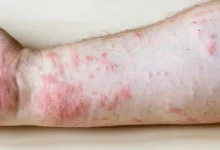Vitiligo, commonly referred to in Arabic as “البهاق,” is a chronic skin condition characterized by the loss of pigmentation, resulting in the development of lighter patches on the skin. This condition can affect people of any age, race, or gender and is marked by a progressive loss of melanin, the pigment responsible for skin color.
Overview
Vitiligo is an autoimmune disorder where the immune system mistakenly targets and destroys melanocytes, the cells responsible for producing melanin. This results in the formation of distinct, depigmented patches on the skin. The condition can vary in severity, with patches appearing localized to specific areas or spreading across larger areas of the body.
Causes and Risk Factors
The exact cause of vitiligo remains unclear, but several factors are believed to contribute to its development:
-
Genetic Predisposition: There is evidence suggesting that vitiligo can run in families, indicating a potential genetic component to the condition. Specific genes may predispose individuals to develop the disease.
-
Autoimmune Reaction: Vitiligo is often associated with other autoimmune disorders such as thyroid disease, type 1 diabetes, and rheumatoid arthritis. The immune system’s attack on melanocytes is thought to be a central mechanism in the disease’s progression.
-
Skin Trauma: Physical trauma to the skin, such as cuts or severe sunburn, may trigger or worsen vitiligo in some individuals.
-
Environmental Factors: Exposure to certain chemicals, such as those used in hair dye, and excessive sun exposure may play a role in the onset of vitiligo.
-
Stress: Psychological stress is sometimes cited as a potential trigger for the development or exacerbation of vitiligo, although its precise role is still under investigation.
Symptoms and Diagnosis
The primary symptom of vitiligo is the appearance of lighter patches of skin, which may vary in size and shape. These patches typically begin in areas of the body that are frequently exposed to the sun, such as the hands, face, and arms, but can appear anywhere on the body. Other symptoms may include:
- Premature Graying of Hair: In some cases, vitiligo can cause premature graying or whitening of the hair on the affected areas.
- Sensitivity: The depigmented skin can be more sensitive to sunlight and may burn more easily.
Diagnosis of vitiligo is usually based on clinical examination. A dermatologist will evaluate the appearance and distribution of the skin patches. In some cases, additional tests may be performed to rule out other conditions with similar symptoms or to identify underlying autoimmune disorders. These tests can include:
- Wood’s Lamp Examination: This involves using a special light to examine the skin, which can help highlight areas affected by vitiligo.
- Skin Biopsy: A small sample of skin may be taken and examined under a microscope to confirm the diagnosis and rule out other skin disorders.
- Blood Tests: These tests may be conducted to check for underlying autoimmune conditions or thyroid abnormalities.
Treatment and Management
There is currently no cure for vitiligo, but various treatments can help manage the condition and improve the appearance of the skin. Treatment options may include:
-
Topical Corticosteroids: These medications are commonly used to reduce inflammation and may help restore pigmentation in some cases.
-
Topical Calcineurin Inhibitors: These drugs, such as tacrolimus and pimecrolimus, are sometimes used as an alternative to corticosteroids, particularly for sensitive areas like the face.
-
Phototherapy: This treatment involves exposing the skin to ultraviolet (UV) light, which can stimulate melanocytes and promote repigmentation. It is often used in combination with other treatments.
-
Depigmentation Therapy: In cases where vitiligo is widespread, some patients may choose to undergo depigmentation therapy to lighten the remaining pigmented skin, creating a more uniform skin tone.
-
Surgical Treatments: Procedures such as skin grafting or melanocyte transplantation may be considered for individuals with stable vitiligo who have not responded to other treatments.
-
Cosmetic Solutions: Patients may use cosmetic products such as self-tanning creams or makeup to conceal the affected areas of the skin.
Psychological and Social Impact
Vitiligo can have a significant impact on an individual’s psychological well-being and quality of life. The visible nature of the condition can lead to self-esteem issues, social anxiety, and emotional distress. Support from healthcare professionals, counseling, and support groups can be beneficial in addressing these challenges.
Living with Vitiligo
Living with vitiligo involves managing both the physical and emotional aspects of the condition. Sun protection is crucial, as the depigmented skin is more susceptible to sunburn. Using sunscreen and wearing protective clothing can help safeguard the skin from UV damage.
Embracing a positive outlook and seeking support from others who understand the condition can also help individuals cope with the challenges of living with vitiligo. Awareness and education about the condition can promote acceptance and reduce stigma.
Research and Future Directions
Ongoing research aims to better understand the underlying mechanisms of vitiligo and develop more effective treatments. Advances in genetic research, immunotherapy, and regenerative medicine hold promise for new therapeutic approaches. Clinical trials are continually exploring novel treatments, including potential vaccines and gene therapies.
In summary, vitiligo is a complex skin condition characterized by the loss of pigmentation, leading to lighter patches on the skin. While there is no cure, various treatments can help manage the condition and improve the appearance of the skin. Addressing the psychological and social impacts is also an essential aspect of comprehensive care. Continued research offers hope for more effective treatments and a deeper understanding of this condition.

